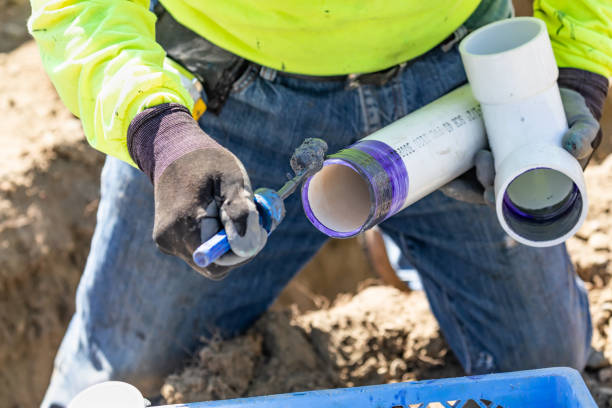The success and longevity of any plumbing system hinge on the judicious selection of materials during the installation phase. The lifeblood of our houses and structures, water pipes face a variety of challenges, from changes in water pressure to corrosive substances in the water. This article delves into the significance of selecting appropriate materials for the installation of water pipes. It examines the qualities that set certain materials apart and the effects they have on the overall longevity and performance of the plumbing system.
1. Copper: A Time-Tested Classic
Copper has long been the gold standard in water pipe materials, and for good reason. This versatile metal boasts exceptional durability and corrosion resistance and is impervious to UV rays. Its malleability makes it easy to work with, allowing for intricate installations. Copper pipes have a proven track record for longevity, often outlasting alternative materials. While copper can be more expensive upfront, its reliability and minimal maintenance requirements make it a cost-effective choice over the long term.
2. PEX (Cross-Linked Polyethylene): Flexibility and Efficiency
In recent years, PEX has gained widespread popularity in water pipe installations, and its versatility is a key factor in this trend. PEX pipes are made from a type of plastic that undergoes a cross-linking process, imparting remarkable flexibility and strength. This flexibility is a game-changer, especially in complex installations where traditional rigid pipes may pose challenges. PEX is also resistant to corrosion and can expand without rupturing, making it highly durable and less prone to leaks.
3. PVC (Polyvinyl Chloride): Cost-Effective and Corrosion-Resistant
PVC, or polyvinyl chloride, is a material that is frequently used in water pipe installations and is reasonably priced. Its smooth inner surface reduces friction, guaranteeing effective water flow, and it has a strong resistance to chemicals and corrosion. PVC pipes are a popular choice for both commercial and residential settings due to their ease of installation and low weight. While PVC may not be as durable as copper, it is still a cost-effective choice for low-budget projects.
4. CPVC (Chlorinated Polyvinyl Chloride): Heat-Resistant Alternative
Chlorine fortification gives CPVC, an improved PVC, more heat resistance. Because of this, CPVC pipes can be used in hot water applications, like those in home water heaters. CPVC is renowned for its dependability, resistance to corrosion, and simplicity of installation. Because it can withstand higher temperatures without losing structural integrity, it’s a good choice for projects requiring consistent hot water distribution.
5. Galvanized Steel: Robust but Prone to Corrosion
Galvanized steel pipes were once a common choice for water installations, especially in older homes. These pipes are coated with a layer of zinc, providing protection against corrosion. While galvanized steel is robust and can withstand high pressure, it has limitations. Over time, the zinc coating can deteriorate, leading to corrosion and restricted water flow. Consequently, galvanized steel is now less favored in modern installations due to its susceptibility to rust and the availability of more advanced alternatives.
6. HDPE (High-Density Polyethylene): Corrosion-Resistant and Eco-Friendly
High-Density Polyethylene (HDPE) pipes are becoming more and more popular in the plumbing industry due to their exceptional resistance to corrosion and chemicals. Strong and flexible, HDPE remains unaffected by temperature and soil composition variations. Moreover, HDPE pipes are eco-friendly since they can be manufactured from recycled materials and are recyclable. HDPE is a popular choice for water pipe installations because of its dependability and low maintenance requirements, particularly for projects that place a high priority on environmental sustainability.
7. Brass: Durable and Resistant to Corrosion
A balance between robustness, resistance to corrosion, and visual appeal can be found in brass pipes. Brass is a strong alloy made of copper and zinc that is resistant to corrosion and can tolerate high pressure. Brass pipes are a popular choice for visible plumbing installations since they are aesthetically pleasing. Brass is a more expensive material than other materials, but in some applications, its strength and aesthetic appeal make it a better option.
8. Cast Iron: Sturdy for Underground Applications
Cast iron pipes have a long history of use in plumbing, particularly for sewer and drain lines. Cast iron pipes are well-known for their durability and ability to withstand external pressures, making them perfect for subterranean installations where they might be exposed to large loads. However, their use has decreased in favor of more contemporary and lightweight materials due to their weight and susceptibility to rust over time.
9. Composite Pipes: Combining Strength and Flexibility
Composite pipes, often made by combining layers of different materials, aim to capitalize on the strengths of each component. For example, a composite pipe might have an inner layer of PEX for flexibility and an outer layer of aluminum for added strength. These pipes offer a balanced combination of characteristics, making them suitable for a variety of applications where the unique benefits of multiple materials are desirable.
10. Corrugated Stainless Steel Tubing (CSST): Flexibility for Gas Lines
While not used for water lines, corrugated stainless steel tubing (CSST) is worth mentioning for its application in gas line installations. CSST is flexible and can be easily bent, making it an efficient choice for navigating through tight spaces. It is corrosion-resistant and significantly reduces the number of joints required in the installation, minimizing the potential points of failure.
Conclusion
The selection of materials for water pipe installation is a critical decision that impacts the longevity, functionality, and maintenance requirements of a plumbing system. Each material has unique benefits and drawbacks, and a variety of factors, such as project requirements, financial constraints, and environmental considerations, impact the selection process. Future water pipe installations will probably be shaped by new materials and innovations that arise as technology develops, guaranteeing the supply of dependable and leak-free plumbing systems.

